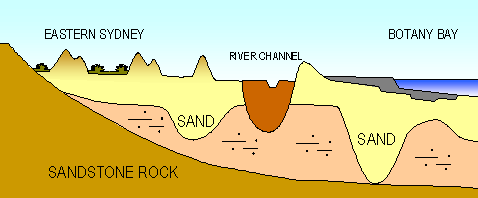Posted 14 August 2007

Profile of the Botany sand aquifer showing groundwater flow through the Botany Sands
Scientists have proposed the use of recycled water as a means of maintaining sustainable levels of groundwater resources in Sydney.
Beneath a large area of eastern Sydney lies a considerable supply of naturally occurring groundwater known as the Botany sand aquifer.
Seeping through saturated layers of sand, silt and clay up to 65m thick, this underground reservoir continuously creeps from north to south into Botany Bay by filtering between the sediment particles, following the buried paths of ancient river valleys gouged into the bedrock hundreds of thousands of years ago.
Water has been sourced from the Botany sand aquifer for nearly 200 years, and there are currently more than 600 bores in operation. The quantity of water currently being extracted is not known.
Before urban development, this underground water source was primarily replenished - or recharged - by rainfall. However, because runoff from rainfall in urban areas is contained by stormwater drainage systems, and water is being pumped out of the aquifer by bores, the delicate balance between inflow and outflow that maintains this constant supply of groundwater may be under threat.
In a recent publication, researchers from the University of New South Wales Water Research Laboratory (UNSW WRL) have proposed that water supplies in the Botany sand aquifer be maintained by managed aquifer recharge (MAR) using recycled water from readily available sources to top up groundwater levels.
Wendy Timms, Ian Acworth and Alexandra Badenhop have identified stormwater as a possible source of recharge that could be diverted into the underground reservoir to replenish supplies. Requiring relatively little treatment, the modifications to infrastructure for the diversion and storage of stormwater could be made at a moderate cost.
However runoff from rainfall does provides neither a predictable nor constant freshwater supply. Furthermore, the increasing rate of extraction for urban and industrial use requires greater quantities of recharge from other more reliable sources.
One such source is the water that flows through the sewerage system. 'Sewer mining' is the process of extracting and treating wastewater from sewerage systems for further use. While a potentially more costly source of recharge, sewerage systems contain constant volumes of water that are reliable and independent of climate.
The researchers suggest that methods of replenishing the underground supplies from these sources could include direct injection into boreholes; construction of underground reservoirs by damming the groundwater flow; or the use of tanks, dams or ponds with porous sides to allow seepage into the ground.
A key issue arising from the reuse of stormwater and sewage wastewater is that of chemical and biological contaminants. Processing of water from these sources to reduce these contaminants to acceptable levels would be an essential part of any recharge system based on stormwater and wastewater recycling. One advantage of sand aquifers is that some contaminants are filtered naturally as water flows between the fine particles of sediment.
Water resources in a number of populated centres around the world are already supplied by treated recycled water from rivers, stormwater and sewage. Trials are currently underway for the use of up to 74 million litres per day of treated wastewater from a local sewage treatment plant to replenish supplies in the Gnangara groundwater system north of Perth. This aquifer can act as an important environmental buffer for the recycled wastewater.
A managed aquifer recharge programme using stormwater and wastewater to replenish groundwater supplies in the Botany sand aquifer in Sydney could increase the quantity of water that can be extracted from it sustainably while providing this major population centre with a reliable water resource that is less susceptible to the effects of drought and fluctuations in climate.
Groundwater level monitoring data recovered at the end of 2019 from Mystery Road at Breeza on the Liverpool Plains reveals a direct connection between the Gunnedah Formation unconsolidated sands and gravels and the underlying Permian coal measures. The connection is provided by the old deep channel of the Mooki River that cuts down into the coal measures. This is a crucial piece of evidence to be incorporated into groundwater models.
What are the effects of fire on water underground? Let’s think about what happens on the surface, and translate that to what is likely to happen to the subsurface.

The effects of tidal forces on groundwater might be less apparent to us than their effects on the ocean, but they’re just as important.

Dr Oliver Knox has brought together information from some of the industry’s researchers conducting work oncotton-producing soils.
Groundwater research at ANSTO has provided crucial information to support the management of finite groundwater resources appropriately and sustainably—answering questions about groundwater recharge, groundwater age and dynamics, the interaction between surface water and groundwater and salinisation.